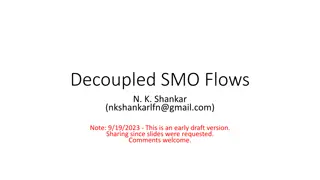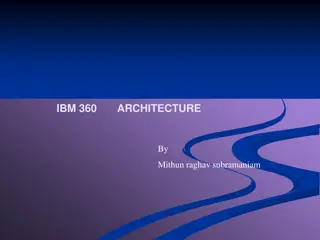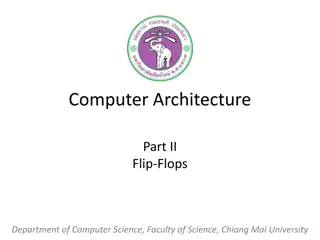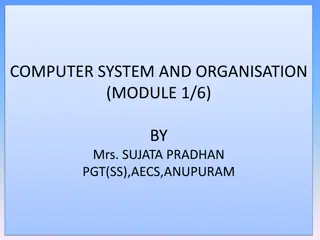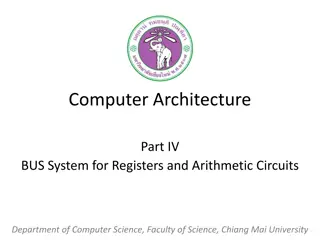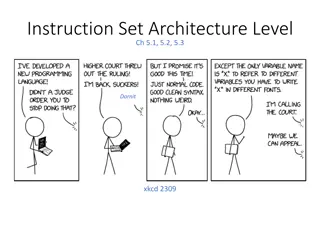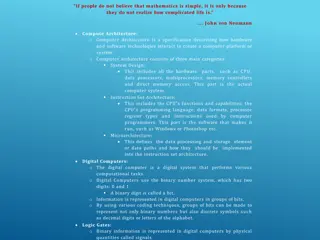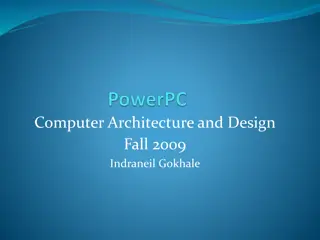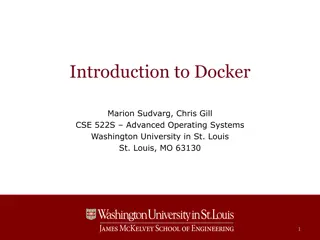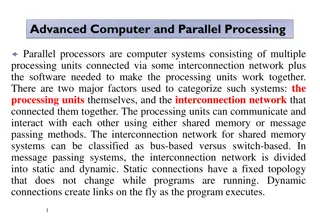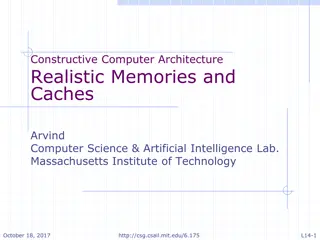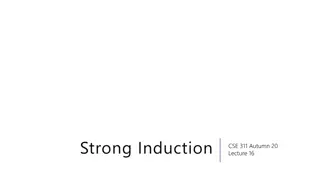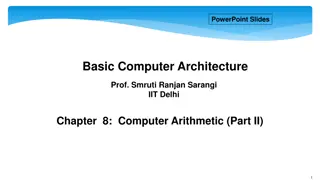CSE 502: Computer Architecture
Prefetching in computer architecture involves fetching data ahead of demand to improve performance by reducing latency. This process faces challenges such as determining what to fetch, when to fetch it, and ensuring accuracy and timeliness. Too early or late prefetching can lead to resource wastage or defeat the purpose of prefetching. Different types of prefetching strategies exist, including software-based approaches like hoisting instructions to place prefetched values into registers. Prefetching can help remove loads from the critical path and improve overall system efficiency.
Download Presentation

Please find below an Image/Link to download the presentation.
The content on the website is provided AS IS for your information and personal use only. It may not be sold, licensed, or shared on other websites without obtaining consent from the author.If you encounter any issues during the download, it is possible that the publisher has removed the file from their server.
You are allowed to download the files provided on this website for personal or commercial use, subject to the condition that they are used lawfully. All files are the property of their respective owners.
The content on the website is provided AS IS for your information and personal use only. It may not be sold, licensed, or shared on other websites without obtaining consent from the author.
E N D
Presentation Transcript
CSE502: Computer Architecture CSE 502: Computer Architecture Prefetching
CSE502: Computer Architecture Prefetching (1/3) Fetch block ahead of demand Target compulsory, capacity, (& coherence) misses Why not conflict? Big challenges: Knowing what to fetch Fetching useless blocks wastes resources Knowing when to fetch Too early clutters storage (or gets thrown out before use) Fetching too late defeats purpose of pre -fetching
CSE502: Computer Architecture Prefetching (2/3) Without prefetching: L1 L2 DRAM Load Data Total Load-to-Use Latency time With prefetching: Prefetch Data Load Much improved Load-to-Use Latency Or: Data Prefetch Load Somewhat improved Latency Prefetching must be accurate and timely
CSE502: Computer Architecture Prefetching (3/3) Without prefetching: Run With prefetching: Load time Prefetching removes loads from critical path
CSE502: Computer Architecture Common Types of Prefetching Software Next-Line, Adjacent-Line Next-N-Line Stream Buffers Stride Localized (e.g., PC-based) Pointer Correlation
CSE502: Computer Architecture Software Prefetching (1/4) Compiler/programmer places prefetch instructions Put prefetched value into Register (binding, also called hoisting ) May prevent instructions from committing Cache (non-binding) Requires ISA support May get evicted from cache before demand
CSE502: Computer Architecture Software Prefetching (2/4) Hoisting must be aware of dependencies R1 = [R2] PREFETCH[R2] A A A R1 = R1- 1 R1 = R1- 1 B C B C B C R1 = [R2] R3 = R1+4 R1 = [R2] R3 = R1+4 R3 = R1+4 Using a prefetch instruction can avoid problems with data dependencies Hopefully the load miss is serviced by the time we get to the consumer (Cache misses in red)
CSE502: Computer Architecture Software Prefetching (3/4) for (I = 1; I < rows; I++) { for (J = 1; J < columns; J++) { prefetch(&x[I+1,J]); sum = sum + x[I,J]; } }
CSE502: Computer Architecture Software Prefetching (4/4) Pros: Gives programmer control and flexibility Allows time for complex (compiler) analysis No (major) hardware modifications needed Cons: Hard to perform timely prefetches At IPC=2 and 100-cycle memory move load 200 inst. earlier Might not even have 200 inst. in current function Prefetching earlier and more often leads to low accuracy Program may go down a different path Prefetch instructions increase code footprint May cause more I$ misses, code alignment issues
CSE502: Computer Architecture Hardware Prefetching (1/3) Hardware monitors memory accesses Looks for common patterns Guessed addresses are placed into prefetch queue Queue is checked when no demand accesses waiting Prefetchers look like READ requests to the hierarchy Although may get special prefetched flag in the state bits Prefetchers trade bandwidth for latency Extra bandwidth usedonly when guessing incorrectly Latency reduced only when guessing correctly No need to change software
CSE502: Computer Architecture Hardware Prefetching (2/3) Processor Potential Prefetcher Locations Registers I-TLB L1 I-Cache L1 D-Cache D-TLB L2 Cache L3 Cache (LLC) Main Memory (DRAM)
CSE502: Computer Architecture Hardware Prefetching (3/3) Processor Intel Core2 Prefetcher Locations Registers I-TLB L1 I-Cache L1 D-Cache D-TLB L2 Cache L3 Cache (LLC) Real CPUs have multiple prefetchers Usually closer to the core (easier to detect patterns) Prefetching at LLC is hard (cache is banked and hashed)
CSE502: Computer Architecture Next-Line (or Adjacent-Line) Prefetching On request for line X, prefetch X+1 (or X^0x1) Assumes spatial locality Often a good assumption Should stop at physical (OS) page boundaries Can often be done efficiently Adjacent-line is convenient when next-level block is bigger Prefetch from DRAM can use bursts and row-buffer hits Works for I$ and D$ Instructions execute sequentially Large data structures often span multiple blocks Simple, but usually not timely
CSE502: Computer Architecture Next-N-Line Prefetching On request for line X, prefetch X+1, X+2, , X+N N is called prefetch depth or prefetch degree Must carefully tune depth N. Large N is More likely to be useful (correct and timely) More aggressive more likely to make a mistake Might evict something useful More expensive need storage for prefetched lines Might delay useful request on interconnect or port Still simple, but more timely than Next-Line
CSE502: Computer Architecture Stream Buffers (1/2) What if we have multiple inter-twined streams? A, B, A+1, B+1, A+2, B+2, Can use multiple stream buffers to track streams Keep next-N available in buffer On request for line X, shift buffer and fetch X+N+1 into it
CSE502: Computer Architecture Stream Buffers (2/2) FIFO Avoid cache pollution of aggressive prefetching FIFO Memory interface Each buffer holds one stream Sequentially-prefetched lines Next-N available in buffer Cache On miss, check head of all buffers If match, pop the entry from FIFO, fetch the N+1st line into the buffer If no match, allocate a new stream buffer (use LRU for recycling) FIFO FIFO
CSE502: Computer Architecture Stride Prefetching (1/2) Elements in array of structs Column in matrix Access patterns often follow a stride Accessing column of elements in a matrix Accessing elements in array of structs Detect stride S, prefetch depth N Prefetch X+1 S, X+2 S, , X+N S
CSE502: Computer Architecture Stride Prefetching (2/2) Must carefully select depth N Same constraints as Next-N-Line prefetcher How to determine if A[i] A[i+1] or X Y ? Wait until A[i+2] (or more) Can vary prefetch depth based on confidence More consecutive strided accesses higher confidence Last Addr Stride Count N New access to A+3N >2 A+2N 2 Do prefetch? = + + A+4N Update count
CSE502: Computer Architecture Localized Stride Prefetchers (1/2) What if multiple strides are interleaved? No clearly-discernible stride Could do multiple strides like stream buffers Expensive (must detect/compare many strides on each access) Accesses to structures usually localized to an instruction Miss pattern looks like: Load R1 = [R2] A, X, Y, A+N, X+N, Y+N, A+2N, X+2N, Y+2N, Load R3 = [R4] (X-A) (X-A) (X-A) Add R5, R1, R3 (Y-X) (Y-X) (Y-X) Store [R6] = R5 (A+N-Y) (A+N-Y) (A+N-Y) Use an array of strides, indexed by PC
CSE502: Computer Architecture Localized Stride Prefetchers (2/2) Store PC, last address, last stride, and count in RPT On access, check RPT (Reference Prediction Table) Same stride? count++ if yes, count-- or count=0 if no If count is high, prefetch (last address + stride*N) Tag Last Addr Stride Count PCa: 0x409A34 Load R1 = [R2] 0x409 A+3N N 2 If confident about the stride (count > Cmin), prefetch (A+4N) PCb: 0x409A38 Load R3 = [R4] + X+3N N 2 0x409 PCc: 0x409A40 Store [R6] = R5 0x409 Y+2N N 1
CSE502: Computer Architecture Other Patterns Sometimes accesses are regular, but no strides Linked data structures (e.g., lists or trees) A B C D E F Linked-list traversal D F B C Actual memory layout A (no chance to detect a stride) E
CSE502: Computer Architecture Pointer Prefetching (1/2) Data filled on cache miss (512 bits of data) 8029 0 1 4128 90120230 90120758 90120230 90120758 14 4128 Nope Nope Nope Nope Nope Maybe! Maybe! Nope Go ahead and prefetch these (needs some help from the TLB) struct bintree_node_t { int data1; int data2; struct bintree_node_t * left; struct bintree_node_t * right; }; This allows you to walk the tree (or other pointer-based data structures which are typically hard to prefetch) Pointers usually look different
CSE502: Computer Architecture Pointer Prefetching (2/2) Relatively cheap to implement Don t need extra hardware to store patterns Limited lookahead makes timely prefetches hard Can t get next pointer until fetched data block Stride Prefetcher: X Access Latency Access Latency X+2N X+N Access Latency Pointer Prefetcher: A Access Latency B Access Latency C Access Latency
CSE502: Computer Architecture Pair-wise Temporal Correlation (1/2) Accesses exhibit temporal correlation If E followed D in the past if we see D, prefetch E Correlation Table Linked-list traversal D A B C D E F D 10 E F F 00 ? A Actual memory layout A 11 B B D F B C A C B 11 C E C 11 D E E 01 F Can use recursively to get more lookahead
CSE502: Computer Architecture Pair-wise Temporal Correlation (2/2) Many patterns more complex than linked lists Can be thought of as a Markov Model Required tracking multiple potential successors Number of candidates is called breadth Correlation Table Markov Model D D 11 01 C E .2 F .2 .6 1.0 F 11 00 E ? A B C A A 11 01 B C B .67 .2 C B 11 00 C ? .6 .2 E C 11 10 D F D E F .33 .5 1.0 .5 E 11 00 A ? Recursive breadth & depth grows exponentially
CSE502: Computer Architecture Increasing Correlation History Length Longer history enables more complex patterns Use history hash for lookup Increases training time DFS traversal: ABDBEBACFCGCA A B F B D A E D B B C D A B E D E F G B B E B B A C A C Much better accuracy , exponential storage cost
CSE502: Computer Architecture Spatial Correlation (1/2) Database Page in Memory (8kB) page header tuple data Memory tuple slot index Irregular layout non-strided Sparse can t capture with cache blocks But, repetitive predict to improve MLP Large-scale repetitive spatial access patterns
CSE502: Computer Architecture Spatial Correlation (2/2) Logically divide memory into regions Identify region by base address Store spatial pattern (bit vector) in correlation table Correlation Table Region A PCx: A PCx 110 1010001 111 PCy: B Region B PCy 110 0001101 111 To prefetch Queue +
CSE502: Computer Architecture Evaluating Prefetchers Compare against larger caches Complex prefetcher vs. simple prefetcher with larger cache Primary metrics Coverage: prefetched hits / base misses Accuracy: prefetched hits / total prefetches Timeliness: latency of prefetched blocks / hit latency Secondary metrics Pollution: misses / (prefetched hits + base misses) Bandwidth: total prefetches + misses / base misses Power, Energy, Area...
CSE502: Computer Architecture Hardware Prefetcher Design Space What to prefetch? Predictors regular patterns (x, x+8, x+16, ) Predicted correlated patterns (A B->C, B..C->J, A..C->K, ) When to prefetch? On every reference lots of lookup/prefetcher overhead On every miss patterns filtered by caches On prefetched-data hits (positive feedback) Where to put prefetched data? Prefetch buffers Caches
CSE502: Computer Architecture What s Inside Today s Chips Data L1 PC-localized stride predictors Short-stride predictors within block prefetch next block Instruction L1 Predict future PC prefetch L2 Stream buffers Adjacent-line prefetch Spatial predictors (maybe?)
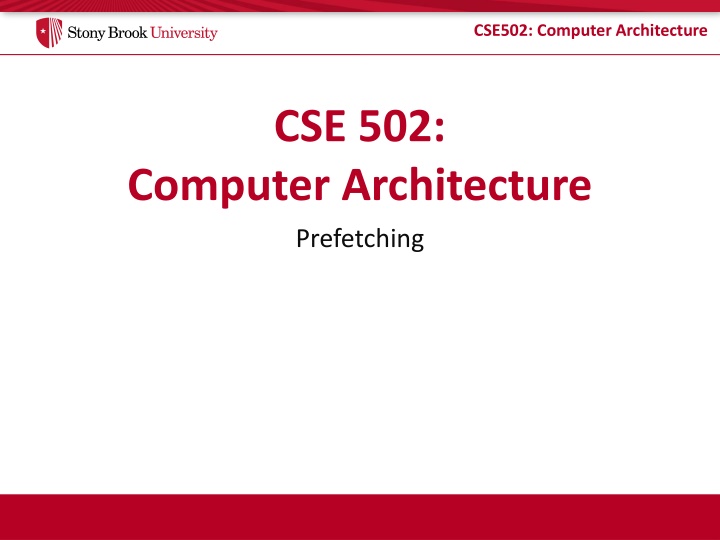

![❤Book⚡[PDF]✔ The Apollo Guidance Computer: Architecture and Operation (Springer](/thumb/21611/book-pdf-the-apollo-guidance-computer-architecture-and-operation-springer.jpg)

